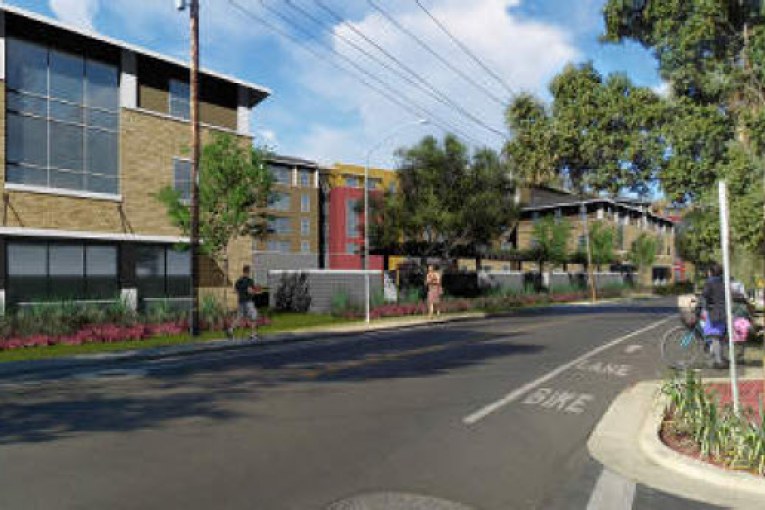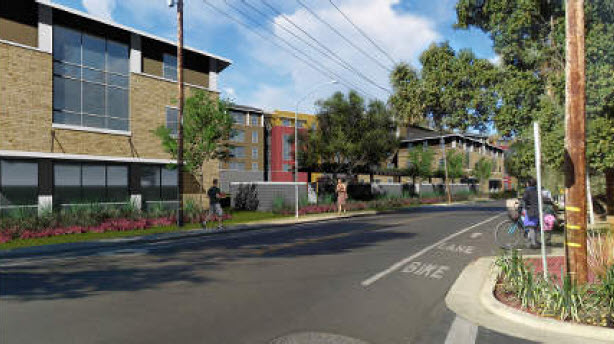

A week after the court surprised many by siding with the plaintiffs against the city on Trackside, the court has in a tentative ruling denied Susan Rainier’s petition requesting a writ of mandate – albeit with a twist, with Judge Stephen Mock ruling that the project is not exempt from CEQA as a sustainable communities project.
The city formally, through city manager Mike Webb, declined comment on the issue at this time, though it does disagree with the court on this point. Regardless, the court ruled that the petition for writ was denied because the project’s EIR was legally adequate.
The court has canceled the oral argument scheduled for March 22, however, it is offering an afternoon hearing either April 5 (the same day as Trackside) or the following Friday, April 12.
In March of 2018, the city council approved the Lincoln40 student housing project on a 5-0 vote. The project is a 130-unit, student-oriented apartment building on 5.92 acres, located along Olive Drive and Hickory Lane just south of the Union Pacific Railroad Tracks and the Davis Amtrak station. The project will contain 708 beds, a bike barn, parking areas, swimming pool, and various amenities.
In early April, following approval, the city received a letter from the Sacramento-based firm, Soluri Meserve, in which they wrote, “Petitioner Susan Rainier intends to file a Verified Petition for Writ of Mandate… against the City of Davis.”
In the subsequent petition, they argue that the city “acted arbitrarily and capriciously when certifying the EIR and approving the Project Entitlements.” They argue further that Ms. Rainier has  “been harmed” by the city’s “failure to provide environmental documents that accurately and fully inform interested persons of the Project’s true impacts.”
“been harmed” by the city’s “failure to provide environmental documents that accurately and fully inform interested persons of the Project’s true impacts.”
In ruling against the city on the CEQA exemption, the court rules that “neither the planning commission meeting agenda from January 10, 2018, nor the city council hearing agenda from March 13, 2018, discuss the exemption from CEQA or the sustainable communities finding.”
The court rules, therefore, that the city’s “notice of the ground for its exemption determination was insufficient” and adds “petitioner was not required to administratively exhaust to assert that the Project is not subject to the CEQA exemption.”
The court further rules that the project fails to meet “the requirements of a sustainable communities project because the City did not perform a preliminary endangerment assessment.”
Due to this, the court writes “the Project does not meet the requirements of Public Resources Code section 21155.1(a)(4) and therefore is not exempt from CEQA review.”
Nevertheless, the court has ruled that the writ is denied because the project EIR is “legally adequate.”
The court here notes that an EIR is under the law “presumed to be legally adequate” and thus the challenging part “bears the burden of establishing otherwise.” The court rules that Ms. Rainier, the petitioner, “has not met that burden.”
Susan Rainier in her complaint raised six grounds for arguing that the CEQA analysis was inadequate. These were all rejected by the court.
Judge Mock rules, “The EIR adequately discusses the health impacts of the contaminated groundwater.” Here he notes: “CEQA does not require an agency to consider the impact of existing conditions on future project users except when a proposed project risks exacerbating those environmental hazards or conditions that already exist.”
In this case, Judge Mock determines that the city was “required to analyze the potential impact of exacerbated conditions on future residents or users” but decides, “The City’s explanation that certain environmental effects were determined not to be significant provides enough detail for the public to discern the analytic basis for the City’s decision.”
Second, “The City was not required to recirculate the EIR due to new contamination information.”
Here he rules: “Substantial evidence supports the City’s decision not to recirculate the EIR due to new contamination information. The draft EIR already contained a discussion and evaluation of the potential impacts of the contaminated groundwater. It found that there were no potential significant impacts, and did not recommend additional investigation.”
Following public comment, the city investigated further, but its expert concluded “that there were still no potential impacts.” Judge Mock writes, “The update here merely amplifies the prior EIR.”
Third, Judge Mock has ruled that the EIR adequately discusses cumulative traffic impacts. Again he determines: “The City’s conclusion that the cumulative traffic impact is less than significant with the implementation of mitigation is supported by substantial evidence. The transportation analysis is clearly adequate.”
Here he rules that “(the) petitioner fails to present evidence that the alleged deficiencies from the cumulative analysis were of such a severity and significance that they prevented public participation and informed decision making.”
Fourth, he determines, “The EIR adequately analyzes cumulative air quality impacts.”
He writes: “The air quality analysis in the EIR appropriately considers the potential cumulative impact of emissions from Project construction.”
The judge notes that the Yolo-Solano Air Quality Management District sets the thresholds for significance of air pollutants and the city makes the determination that “project construction-related and operational emissions were below YSAQMD’s thresholds of significance, the draft EIR provides substantial evidence that the cumulative impact of the criteria air pollutants is less than significant.”
Moreover, he rules, “Petitioner erroneously asserts that the significance threshold in the EIR used to analyze operational air quality impacts was not applied in the EIR to the Project’s construction impacts. This threshold was used in the draft EIR. Petitioner has not presented any evidence that supports her claim that the City was required to analyze the Project’s potential impacts from toxic air contaminants emissions beyond that of diesel particulate matter.”
Fifth, he notes, “Since petitioner did not challenge the EIR’s analysis of noise impacts in her petition, the Court does not consider this argument.”
Finally he rules that the EIR adequately discusses cumulative habitat loss impacts. The EIR here does not require additional biological resources mitigation. He also notes that since the petitioner did not challenge the EIR’s analysis of tree impacts in her petition, the court does not consider this argument.
Members of the council either declined comment or did not respond to requests for comment. The ruling remains tentative, pending a full hearing.
—David M. Greenwald reporting


Very interesting decisions (one, tentative) that were, or are about to be, made…
The first, that although it appears that someone on staff believed it was CEQA exempt, it was decided to follow the CEQA process, including EIR anyhow… damn good decision… one that was missed with the original review of the Hotel project on Richards, where some staff recommended a focused EIR on circulation/traffic, but City decided not to… that bit them in the arse.
In this case, the City proceeded with the “belt and suspenders” approach… that it might be exempt from the requirement of an EIR, “but let’s go ahead and do one anyway”. Appears that was a damn good call!
Misconception: despite what was implied somewhat in the article, and in the suit itself, all projects are subject to CEQA review… but that review, including Initial Study, judging the project under CEQA guidelines and law, might end with a Cat Ex, Stat Ex, Neg Dec (with or without ‘conditions’), focused EIR or full EIR… all of these fall under the umbrella of CEQA review… the judge intends to note that… good (tentative) call!
CEQA compliance DOES NOT MEAN a full-blown EIR is needed for a project… it depends… but CEQA review is required.
Just saying…
BTW, the context is different between Trackside and Lincoln 40 as to the legal issues… olives and watermelons…
Not to YIYBY’s that truly believe.
This is huge. It means Nishi lawsuit will go down as well. 708 beds at Lincoln40 will allow us students to finally relieve a little stress. People like Susan rainier don’t know how much stress they’ve put us under.
Funny, those who are actually affected by this project had very open communication with the developers, who listened to everyone and actually did their very best to mitigate harm to any reasonable degree that they could. To that point they helped residents who intended to be renting long-term at the site to find new housing — to the point they signed an MOU with our neighborhood on several issues — to the point that they gave us phone numbers to call them personally to discuss any issues. They didn’t meet every single ask, but we mutually worked out what was reasonable and possible. High Five Lincoln 40! Good developers are hard to find . . . and though rare, they do exist.
Good points… good precedent for project developers/proponents…
What are the mechanisms for ‘enforcing’ the MOU? Just curious…
Trust . . . that’s not a joke.